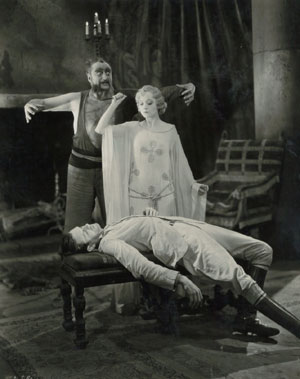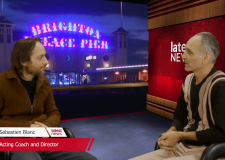Film: Jessica Kellgren-Hayes
Cutting edge in its day, White Zombie is the first feature length zombie film. Whilst we must forgive it many things for being a not-particularly well funded independent film, it is impressive for being a pre cursor.
The story begins in Haiti with a carriage carrying a holidaying couple being stopped by a funeral…which is taking place in the middle of the road. The driver explains that the family do not want the body stolen so they are burying it where regular traffic will keep people from trying. 
The couple later cross paths with an eerie gentleman and his henchmen. The driver again explains that the henchmen are zombies.
The couple, Neil Parker and his fiancé Madeleine, played by old silent film stars John Harron and Madge Bellamy, are staying at the home of Charles Beaumont to be wed.
Unfortunately, Beaumont is rather taken with Madeline and will do anything to have her, including turning her into a zombie! He turns to ‘Murder’ Legendre, zombie master and pretty much a soulless devil. Played by Bela Lugosi he is everything one would want in an old horror film’s villain.
Released in 1932 it is a Pre-Code horror film that allows for much moral ambiguity. The previously moral Dr Bruner attempts to murder the evil Murder by hiding and then stabbing him from behind!
This is exciting in such an old fashioned film (old fashioned even when it was released) with the use of past-it silent film actors like Bellamy and Harron, whose mannerisms and flat line readings are ill-suited to sound film. It also employs a number of Expressionist touches – now considered beautiful – that were certainly falling out of fashion at the time.
When Neil broods over the loss of Madeline in a nightclub we see no other patrons, just their shadows on the wall behind him. The eerie shadows emphasizing how alone and powerless he is.
The film uses sound better than was common at the time; using music to create mood, an uncommon practice in the early years of talking pictures, and often startles the viewer with the use of the piercing cry of a vulture. Despite being occasionally stagy, there is more camera movement than in Dracula, and one scene in Dr. Bruner’s study is done with no cuts- only the camera moves around. Hitchcock would likely have appreciated this experiment in technique!
For more reviews of classic films, subscribe to my YouTube channel, MissJessicaKH and watch Latest TV’s film review show PostFeature, every Wednesday at 6.30pm and repeated through the week. Check listings in this magazine for more!




















